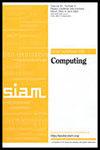随机查询复杂度与量子查询复杂度的最优分离
IF 1.6
3区 计算机科学
Q3 COMPUTER SCIENCE, THEORY & METHODS
引用次数: 2
摘要
我们证明了对于每个决策树,给定阶和的傅里叶系数的绝对值不超过,其中是变量的数量,是树的深度,并且是一个绝对常数。这个界限本质上是紧密的,并且解决了一个猜想,因为Tal[关于量子和随机查询复杂性之间的最佳分离,在第61届IEEE计算机科学基础研讨会(FOCS), 2020年,第228-239页]。我们工作之前的界限迅速退化,已经变得微不足道。作为一种应用,我们得到了对于每一个整数,在比特上的一个部分布尔函数,该函数最大具有有界误差量子查询复杂度和随机查询复杂度。Aaronson和Ambainis [SIAM J. Comput]的结果表明,这种有界错误量子与随机查询复杂性的分离是最好的。和Bravyi等。[经典的关联算法,arXiv预印本,2021]。在我们的工作之前,最著名的分离是多项式弱的:相对于任何[A]。Tal,量子和随机查询复杂性之间的最佳分离,第61届IEEE计算机科学基础研讨会论文集(FOCS), 2020, pp. 228-239]。作为另一个应用,我们获得了对有界误差量子和随机通信复杂性的本质上最优的分离。最好的先前分离是多项式弱的:相对于(这隐含在[A]。Tal,量子和随机查询复杂性之间的最佳分离,第61届IEEE计算机科学基础研讨会论文集(FOCS), 2020, pp. 228-239])。本文章由计算机程序翻译,如有差异,请以英文原文为准。
An Optimal Separation of Randomized and Quantum Query Complexity
We prove that for every decision tree, the absolute values of the Fourier coefficients of a given order sum to at most , where is the number of variables, is the tree depth, and is an absolute constant. This bound is essentially tight and settles a conjecture due to Tal [Towards optimal separations between quantum and randomized query complexities, in Proceedings of the Sixty-First Annual IEEE Symposium on Foundations of Computer Science (FOCS), 2020, pp. 228–239]. The bounds prior to our work degraded rapidly with , becoming trivial already at . As an application, we obtain, for every integer , a partial Boolean function on bits that has bounded-error quantum query complexity at most and randomized query complexity . This separation of bounded-error quantum versus randomized query complexity is best possible, by the results of Aaronson and Ambainis [SIAM J. Comput., 47 (2018), pp. 982–1038] and Bravyi et al. [Classical Algorithms for Forrelation, arXiv preprint, 2021]. Prior to our work, the best known separation was polynomially weaker: versus for any [A. Tal, Towards optimal separations between quantum and randomized query complexities, in Proceedings of the Sixty-First Annual IEEE Symposium on Foundations of Computer Science (FOCS), 2020, pp. 228–239]. As another application, we obtain an essentially optimal separation of versus for bounded-error quantum versus randomized communication complexity for any . The best previous separation was polynomially weaker: versus (this is implicit in [A. Tal, Towards optimal separations between quantum and randomized query complexities, in Proceedings of the Sixty-First Annual IEEE Symposium on Foundations of Computer Science (FOCS), 2020, pp. 228–239]).
求助全文
通过发布文献求助,成功后即可免费获取论文全文。
去求助
来源期刊

SIAM Journal on Computing
工程技术-计算机:理论方法
CiteScore
4.60
自引率
0.00%
发文量
68
审稿时长
6-12 weeks
期刊介绍:
The SIAM Journal on Computing aims to provide coverage of the most significant work going on in the mathematical and formal aspects of computer science and nonnumerical computing. Submissions must be clearly written and make a significant technical contribution. Topics include but are not limited to analysis and design of algorithms, algorithmic game theory, data structures, computational complexity, computational algebra, computational aspects of combinatorics and graph theory, computational biology, computational geometry, computational robotics, the mathematical aspects of programming languages, artificial intelligence, computational learning, databases, information retrieval, cryptography, networks, distributed computing, parallel algorithms, and computer architecture.
 求助内容:
求助内容: 应助结果提醒方式:
应助结果提醒方式:


